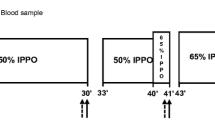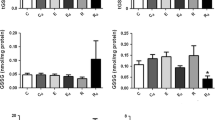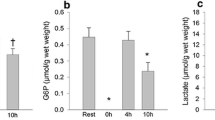Summary
The purposes of these experiments were to compare the activities of glucose 6-phosphate dehydrogenase (G6PDH) and the lysosomal enzyme N-acetyl-Β-glucosaminidase (NAG) in rat muscles and to assess protein degradation after eccentric exercise (running down a 18‡ grade). The following results were obtained: (1) Muscles in which the G6PDH activity was increased also showed an increase in NAG activity that was smaller and occurred later and/or was more prolonged than the increase in G6PDH activity. (2) The urinary 3-methylhistidine/creatinine ratio was statistically elevated for 3 days after eccentric exercise and this increase was much larger and more prolonged than previously observed in rats run on the level. Taken together our results suggest that increased protein degradation after exercise is due to increased proteolysis of muscle tissue damaged during the exercise bout and that lysosomal enzymes may be involved in this degradation.
Similar content being viewed by others
References
Ahlborg B, Brohult J (1967) Immediate and delayed metabolic reaction in well trained subjects after prolonged physical exercise. Acta Med Scand 182: 41–54
Armstrong RB, Marum P, Tullson P, Saubert CW (1979) Acute hypertrophic response of skeletal muscle to removal of synergists. J Appl Physiol 46: 835–842
Armstrong RB, Oglivie RW, Schwane JA (1983) Eccentric exercise-induced injury to rat skeletal muscle. J Appl Physiol 54: 80–93
Ballard FJ, Tomas FM (1983) 3-Methylhistidine as a measure of skeletal muscle protein breakdown in human subjects: The case for its continued use. Clin Sci 65: 209–215
Decombaz J, Reinhardt P, Anantharaman K, Von Glutz G, Poortmans JR (1979) Biochemical changes in a 100 km run: Free amino acids, urea, and creatinine. Eur J Appl Physiol 41: 61–72
Dohm GL, Puente FR, Smith CP, Edge A (1978) Changes in tissue protein levels as a result of endurance exercise. Life Sci 23: 845–850
Dohm GL, Kasperek GJ, Tapscott EB, Beecher GR (1980) Effect of exercise on synthesis and degradation of muscle protein. Biochem J 188: 255–262
Dohm GL, Williams RT, Kasperek GJ, van Rij AM (1982) Increased excretion of urea and NΤ-methylhistidine by rats and humans after a bout of exercise. J Appl Physiol 52: 27–33
Dohm GL, Kasperek GJ, Tapscott EB, Barakat HA (1985) Protein metabolism during endurance. Fed Proc [in press]
Faulkner WR, King JW (1970) Fundamentals clinical chemistry. Tietz NW (eds) Saunders, Philadelphia, PA, pp 698–741
Friden J, Sjostrom M, Eklblom B (1981) A morphological study of delayed muscle soreness. Experientia 37: 506–507
Friden J, Kjorell U, Thornell LE (1984) Delayed muscle soreness and cytoskeletal alterations: An immunocytological study in man. Int J Sports Med 5: 15–18
Gornall AG, Bardawill CJ, David MM (1949) Determination of serum proteins by means of the biuret reaction. J Biol Chem 177: 751–776
Hunter JB, Critz JB (1971) Effects of training on plasma enzyme levels in man. J Appl Physiol 31: 20–23
Noakes TD, Carter JW (1982) The responses of plasma biochemical parameters to a 56-km race in novice and experienced ultra-marathon runners. Eur J Appl Physiol 49: 179–186
Poortmans JR (1984) Protein turnover and amino acid oxidation during and after exercise. Med Sports Sci 17: 130–147
Radha E, Bessman SP (1983) Effect of exercise on protein degradation: 3-Methylhistidine and creatinine excretion. Biochem Med 29: 96–100
Rennie MJ, Millward DJ (1983) 3-Methylhistidine excretion and the urinary 3-methylhistidine/creatinine ratio are poor indicators of skeletal muscle protein breakdown. Clin Sci 65: 217–225
Rennie MJ, Edwards JHT, Krywawych S, Davies CTM, Holliday D, Waterlow JC, Millward DJ (1981) Effect of exercise on protein turnover in man. Clin Sci 61: 627–634
Snyder AC, Lamb DR, Salm CP, Judge MD, Aberle ED, Mills EW (1984) Myofibrillar protein degradation after eccentric exercise. Experientia 40: 69–70
Tomas FM, Murray AJ, Jones LM (1984) Interactive effects of insulin and corticosterone on myofibrillar protein turnover in rats as determined by NΤ-methylhistidine excretion. Biochem J 220: 469–479
Tullson P, Armstrong RB (1981) Muscle hexose monophosphate shunt activity following exercise. Experientia 37: 1311–1312
Vihko V, Salminen A, Rantamaki J (1978) Acid hydrolase activity in red and white skeletal muscle of mice during a two-week period following exhausting exercise. Pflügers Arch 378: 99–106
Wagner KR, Kauffman FC, Max SR (1978) The pentose phosphate pathway in regenerating skeletal muscle. Biochem J 170: 17–22
Wassner SJ, Li JB (1982) NΤ-methylhistidine release: contributions of rat skeletal muscle, GI tract, and skin. Am J Physiol 243: E293-E297
Author information
Authors and Affiliations
Rights and permissions
About this article
Cite this article
Kasperek, G.J., Snider, R.D. Increased protein degradation after eccentric exercise. Europ. J. Appl. Physiol. 54, 30–34 (1985). https://doi.org/10.1007/BF00426294
Accepted:
Issue Date:
DOI: https://doi.org/10.1007/BF00426294




